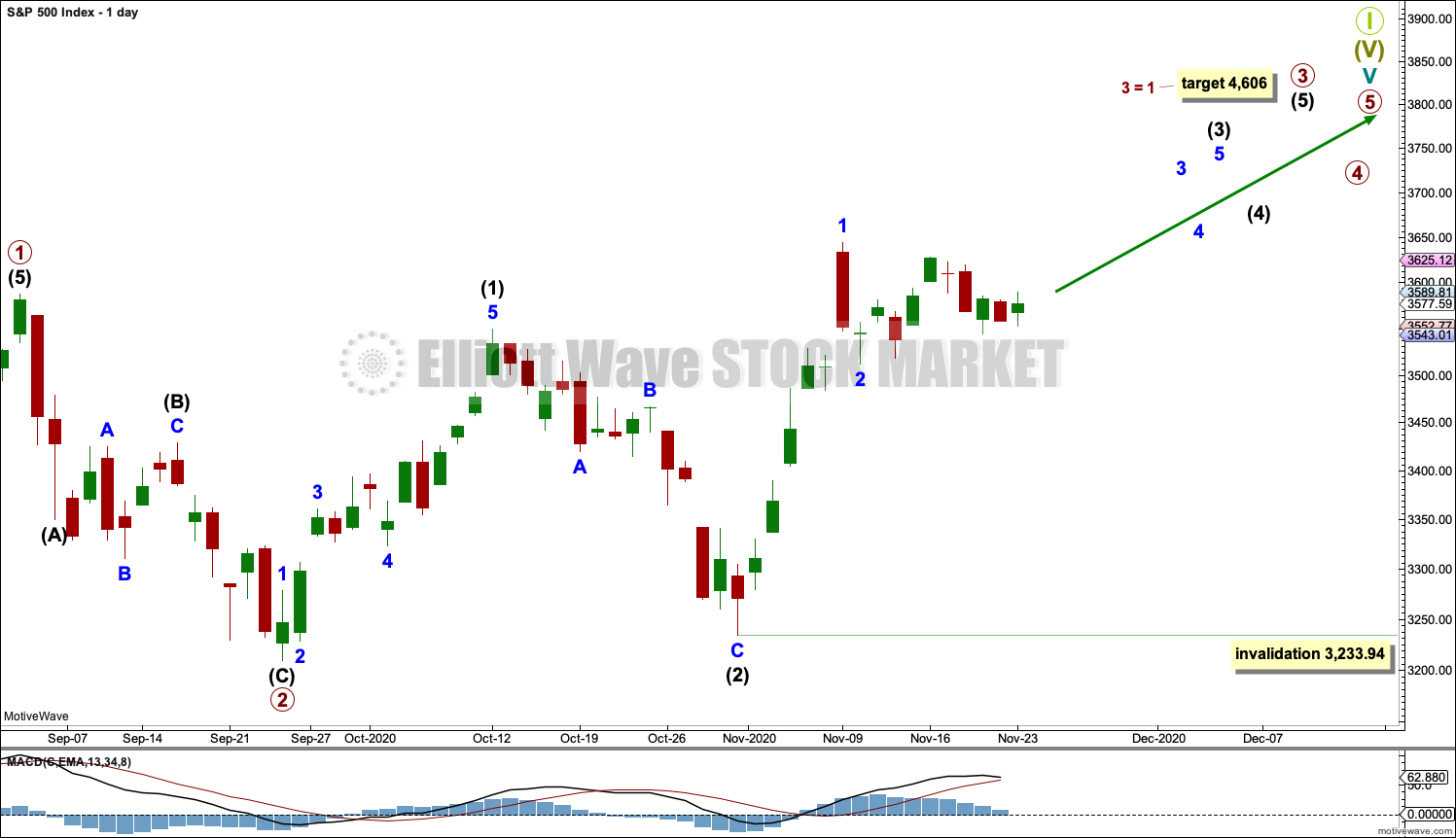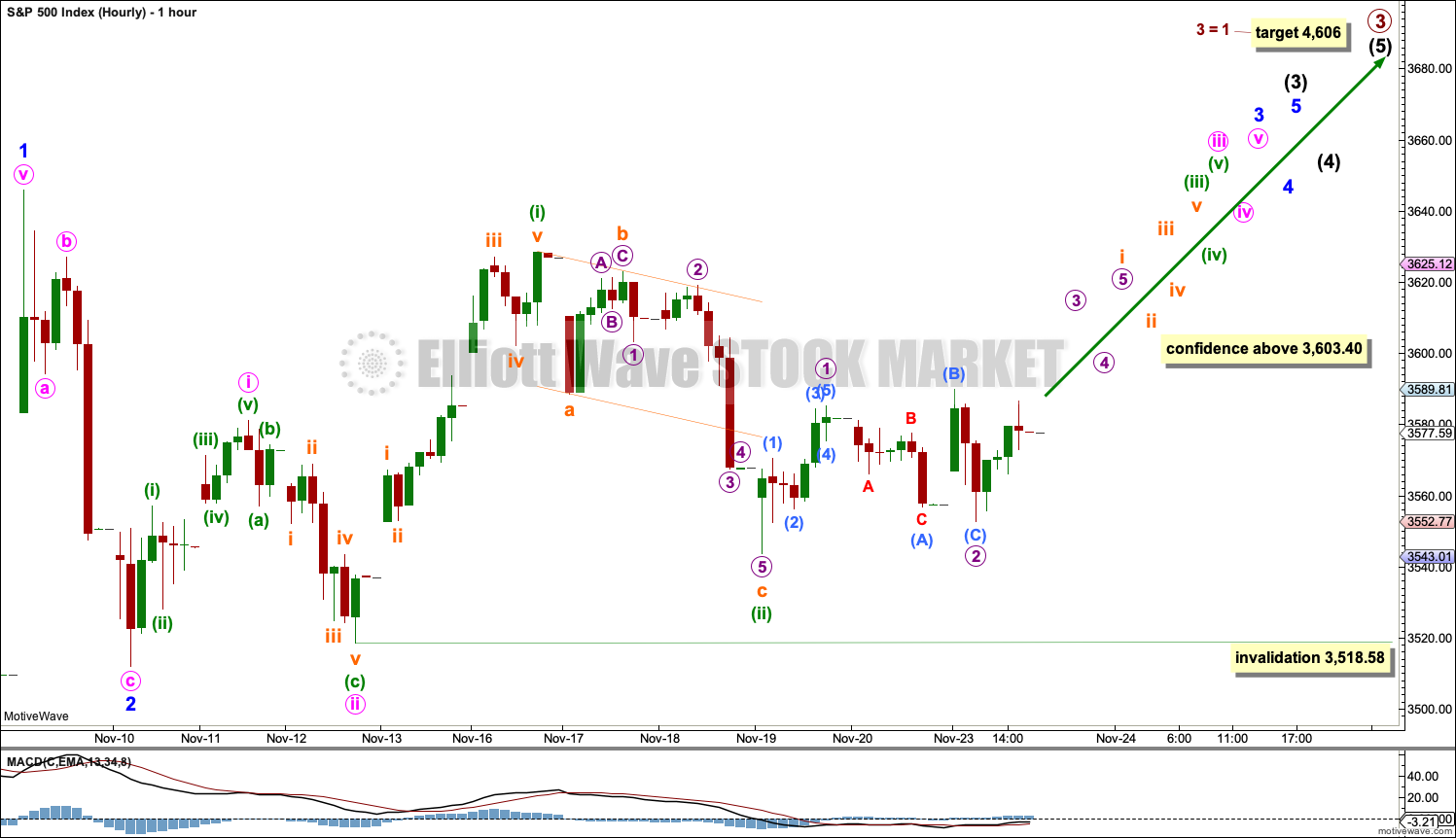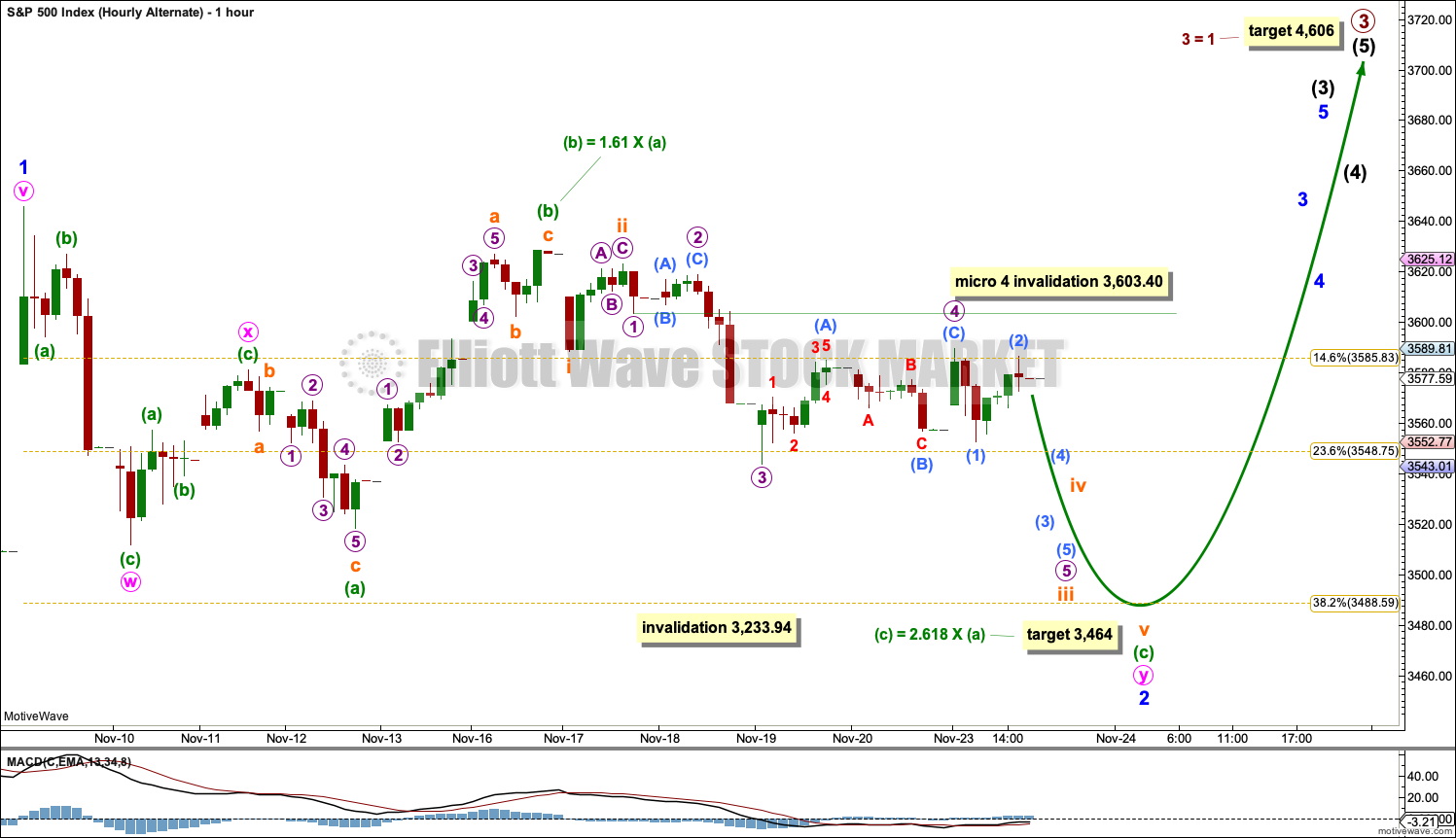S&P 500: Elliott Wave and Technical Analysis | Charts – November 23, 2020
Another small range day has underlying strength, which supports the Elliott wave count.
Summary: The main wave count expects the low of the 30th of October to not be breached. The target is at 4,606 and an invalidation point at 3,233.94.
If the main wave count is invalidated with a new low below 3,233.94 and then 2,191.86, then an alternate may be used. This wave count is very bearish. It expects a strong wave down to a target at 1,708. The invalidation point is 666.76. This alternate wave count does not have support from classic technical analysis.
The biggest picture, Grand Super Cycle analysis, is here.
Monthly charts are last updated here with video here.
ELLIOTT WAVE COUNTS
MAIN WAVE COUNT
WEEKLY CHART
Cycle wave V may last from one to several years. So far it is in its eighth month.
This wave count may allow time for the AD line to diverge from price as price makes final highs before the end of the bull market. The AD line most commonly diverges a minimum of 4 months prior to the end of a bull market.
Cycle wave V would most likely subdivide as an impulse. But if overlapping develops, then an ending diagonal should be considered. This chart considers the more common impulse.
Primary waves 1 and 2 may be complete.
Primary wave 3 may only subdivide as an impulse.
There is already a Fibonacci ratio between cycle waves I and III within Super Cycle wave (V). The S&P500 often exhibits a Fibonacci ratio between two of its actionary waves but rarely between all three; it is less likely that cycle wave V would exhibit a Fibonacci ratio. The target for Super Cycle wave (V) to end would best be calculated at primary degree, but that cannot be done until all of primary waves 1, 2, 3 and 4 are complete.
DAILY CHART
Primary waves 1 and 2 may both be complete. Primary wave 3 may now be underway.
Primary wave 3 may only subdivide as an impulse. Within primary wave 3: Intermediate waves (1) and (2) may both be complete, and intermediate wave (3) may now be underway and may only subdivide as an impulse.
No second wave correction within intermediate wave (3) may move beyond the start of its first wave below 3,233.94.
Primary wave 1 looks extended. The target for primary wave 3 expects it to also be extended.
This wave count now expects that a third wave at three degrees (minor, intermediate and primary) has just begun. An increase in upwards momentum is expected if this wave count is correct.
When third waves extend they do so in price as well as time. Extended waves usually exhibit corrections within them that are more time consuming than those within waves that are not extended. While it remains possible that minor wave 2 may not be over and may yet move lower, any corrections within the market at this time may more likely be short term in nature.
HOURLY CHART
Intermediate wave (3) may only subdivide as an impulse at minor degree.
Minor waves 1 and 2 within intermediate wave (3) may be complete. A third wave up at four degrees may have begun. This wave count expects an increase in upwards momentum.
Minor wave 3 may only subdivide as an impulse. Minute waves i and ii within minor wave 3 may be complete. Minuette wave (ii) within minute wave iii may not move beyond the start of minuette wave (i) below 3,518.58.
It will remain possible that while price remains below 3,603.40 minuette wave (ii) may continue lower. The invalidation point must remain at the start of minuette wave (i).
ALTERNATE HOURLY CHART
Minor wave 2 may continue sideways as a double combination. The first structure in the double may be a zigzag labelled minute wave w. The double may be joined by a complete three in the opposite direction, a zigzag labelled minute wave x. The second structure in the double may be an incomplete expanded flat labelled minute wave y. Minuette wave (b) is beyond the common range of up to 1.38 times the length of minuette wave (a). The probability of this wave count is slightly reduced.
Minuette wave (c) within minute wave y would be extremely likely to make at least a slight new low below the end of minuette wave (a) at 3,518.58 to avoid a truncation and a very rare running flat. A target is re-calculated that expects minuette wave (c) to exhibit a Fibonacci ratio to minuette wave (a).
Combinations are sideways consolidations. When this consolidation is complete, then an upwards breakout to new all time highs would be expected.
Minor wave 2 may not move beyond the start of minor wave 1 below 3,233.94.
This wave count expects that if the pullback for minor wave 2 is not over and continues lower, then it may not be by much and should now be over reasonably quickly this week.
ALTERNATE WAVE COUNT
WEEKLY CHART
To view the material difference between the main and this alternate wave count, monthly charts should be viewed. There is a link to charts, text and video analysis of monthly charts at the top of this analysis.
Cycle wave II may be subdividing as an expanded flat. Primary wave B within the expanded flat is a 1.21 length of primary wave A, which is within the most common range for B waves within flats of up to 1.38. Expanded flats are reasonably common structures.
A 7 point target zone is calculated at two wave degrees.
Cycle wave II may not move beyond the start of cycle wave I below 666.79.
This alternate wave count does not have support from classic technical analysis at this time, so it has a low probability.
DAILY CHART
Primary wave B may be complete as a zigzag. Primary wave C may now begin and must subdivide as a five wave motive structure, most likely an impulse.
Cycle wave II may not move beyond the start of cycle wave I below 666.79.
There is no upper invalidation point for this wave count; primary wave B could continue higher as a double zigzag. The common range for B waves within flat corrections is from 1 to 1.38 times the length of their corresponding A waves. This gives a range within primary wave B that may continue up to 3,850.15. Prior to this price point being reached, it may be possible to discard this alternate wave count based upon technical analysis.
TECHNICAL ANALYSIS
WEEKLY CHART
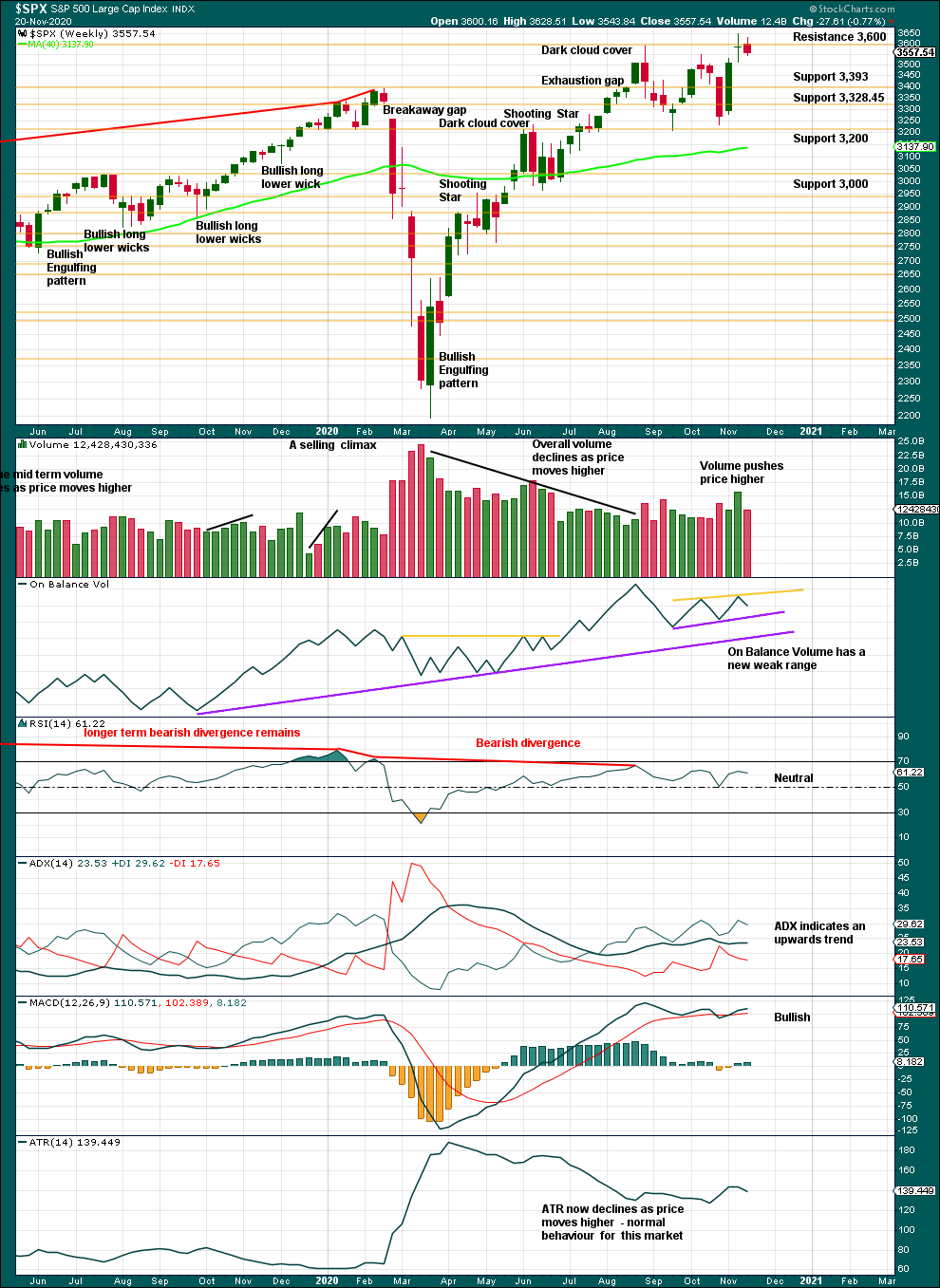
Click chart to enlarge. Chart courtesy of StockCharts.com.
This chart is bullish and supports the main Elliott wave count. All of volume, On Balance Volume, ADX and MACD are bullish. There is no bearish candlestick reversal pattern.
Last week closes as a small range inside week with the balance of volume downwards. Volume within the week has not supported downwards movement.
DAILY CHART

Click chart to enlarge. Chart courtesy of StockCharts.com.
There is an upwards trend. When this market trends, then Stochastics may remain overbought for extended periods of time while price moves a considerable distance.
Overall, this chart is bullish and still supports the main Elliott wave count. There is a series of higher highs and lower lows from the low on the 24th of September.
Another 80% up day supports the main Elliott wave count.
BREADTH – AD LINE
WEEKLY CHART
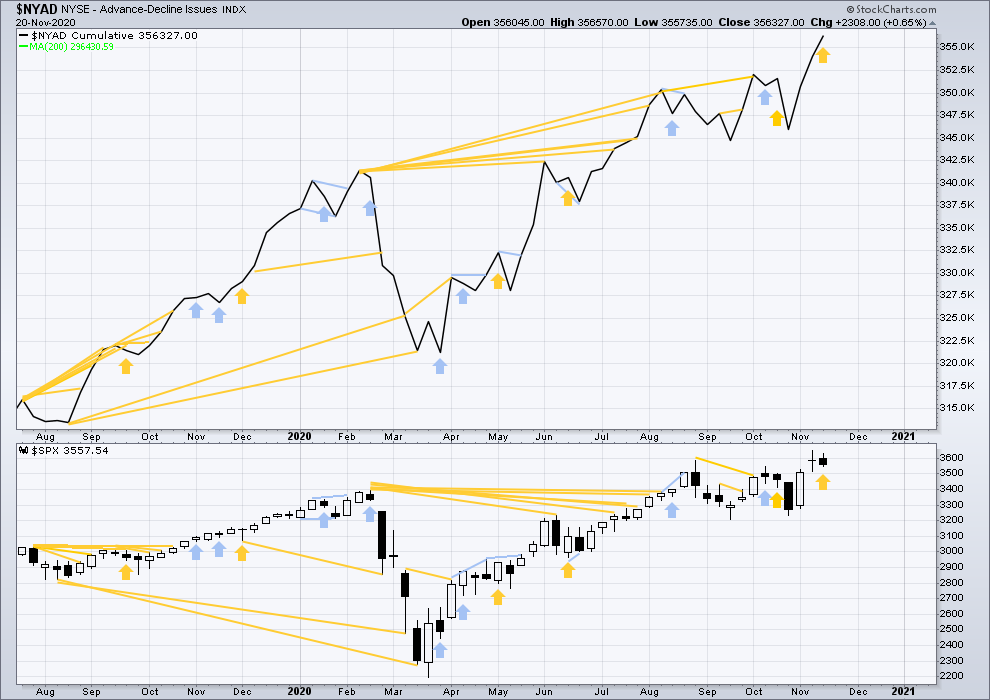
Click chart to enlarge. Chart courtesy of StockCharts.com. So that colour blind members are included, bearish signals will be noted with blue and bullish signals with yellow.
Breadth should be read as a leading indicator.
Lowry’s Operating Companies Only AD line has made another new all time high this week. This is a strong bullish signal and supports the main Elliott wave count.
Large caps all time high: 3,645.99 on November 9, 2020.
Mid caps all time high: 2,190.69 on November 23, 2020.
Small caps all time high: 1,100.58 on August 27, 2018.
Last week the AD line has made a new all time high, but price has not. This divergence is a strong bullish signal that supports the main Elliott wave count.
DAILY CHART

Click chart to enlarge. Chart courtesy of StockCharts.com. So that colour blind members are included, bearish signals will be noted with blue and bullish signals with yellow.
The AD line has made another new all time high. This supports a bullish Elliott wave count.
VOLATILITY – INVERTED VIX CHART
WEEKLY CHART
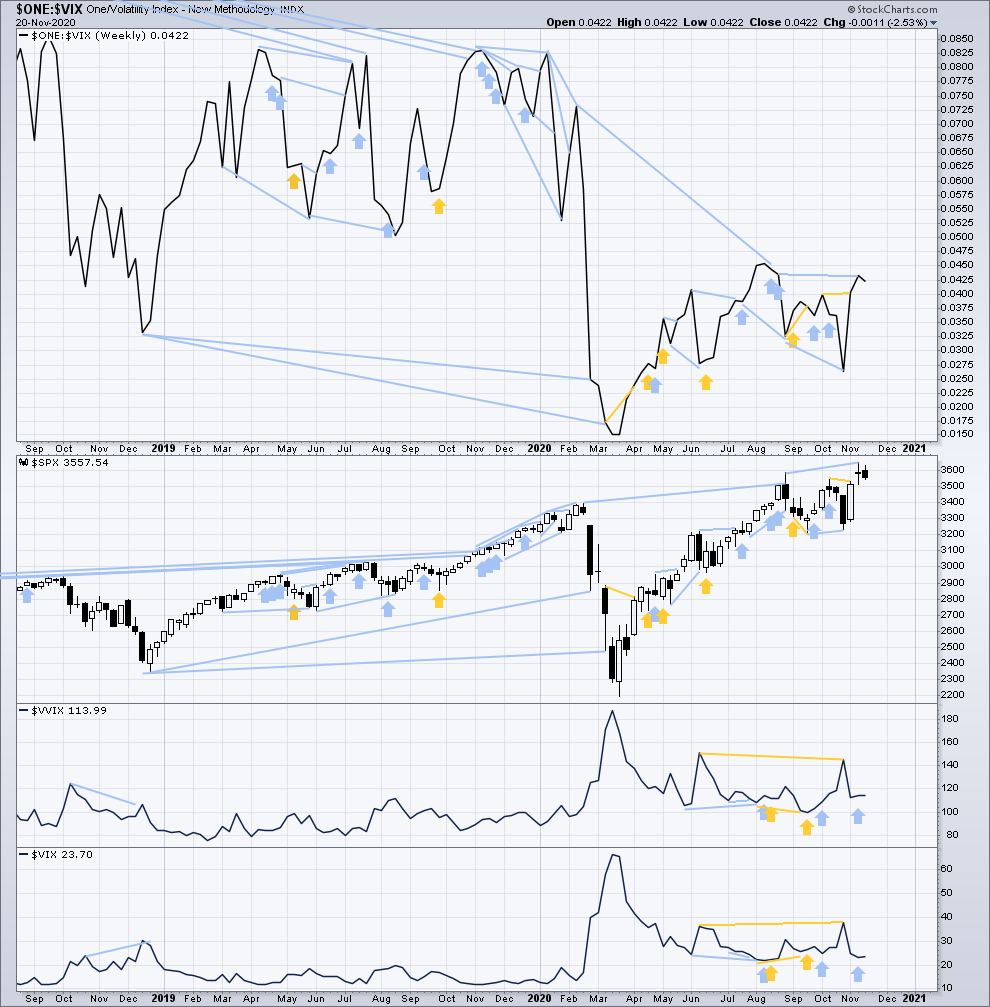
Click chart to enlarge. Chart courtesy of StockCharts.com. So that colour blind members are included, bearish signals will be noted with blue and bullish signals with yellow.
Inverted VIX remains well below all time highs. The all time high for inverted VIX was in the week beginning October 30, 2017. There is over 3 years of bearish divergence between price and inverted VIX. There is all of long, mid and short-term bearish divergence. This supports the alternate Elliott wave count.
Last week price has moved slightly lower and inverted VIX has slightly declined. Neither have made new short-term lows. There is no new short-term divergence.
Comparing VIX and VVIX: Bearish short-term divergence noted two weeks ago has been followed by a little downwards movement, so it may now be resolved. Last week VIX has increased slightly, but VVIX is essentially flat. The difference is so slight that it will not be considered for divergence.
DAILY CHART
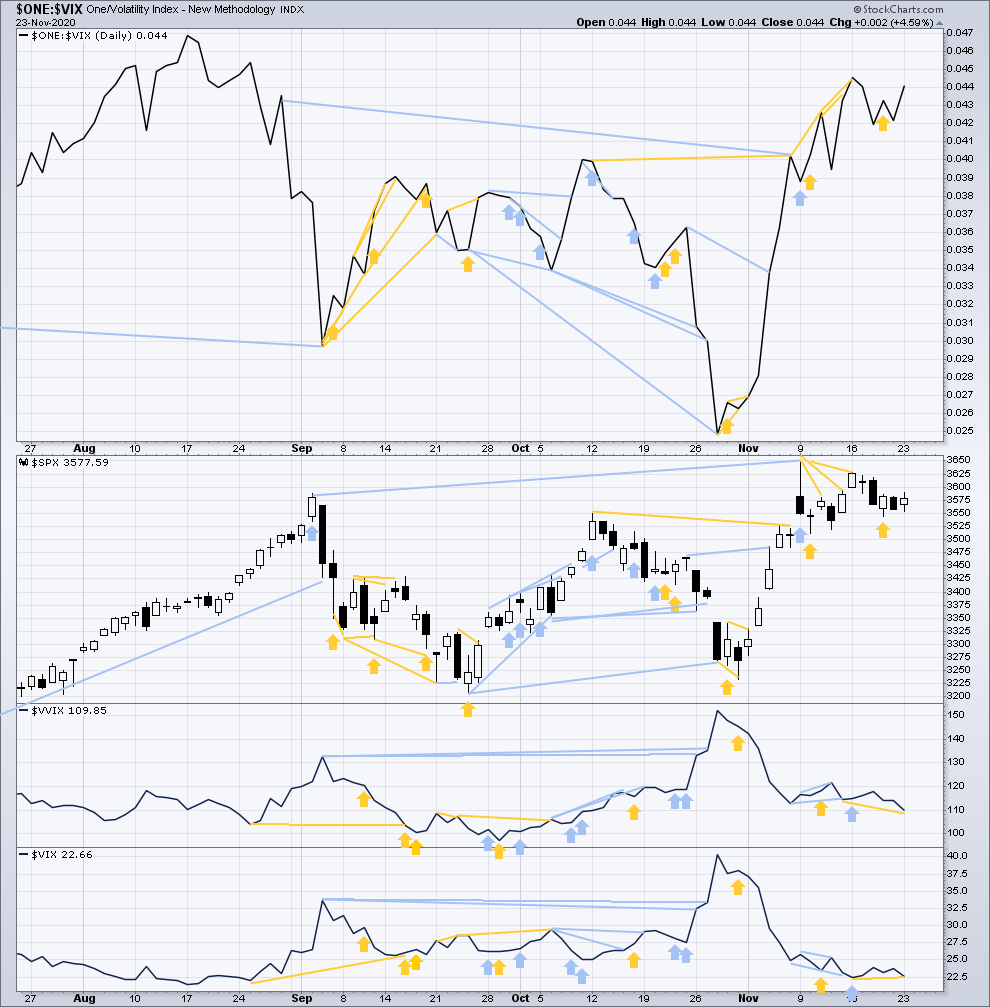
Click chart to enlarge. Chart courtesy of StockCharts.com. So that colour blind members are included, bearish signals will be noted with blue and bullish signals with yellow.
Today both price and inverted VIX have moved higher. Neither have made new short-term highs. There is no new divergence.
Comparing VIX and VVIX at the daily chart level: Both VIX and VVIX have moved lower. VVIX has made a new short-term low below the low of the 16th of November, but VIX has not. VVIX is declining faster than VIX. This divergence is bullish for price.
DOW THEORY
Dow Theory confirms a new bull market with new highs made on a closing basis:
DJIA: 29,568.57 – closed above on 16th November 2020.
DJT: 11,623.58 – closed above on 7th October 2020.
Adding in the S&P and Nasdaq for an extended Dow Theory, confirmation of a bull market would require new highs made on a closing basis:
S&P500: 3,393.52 – closed above on 21st August 2020.
Nasdaq: 9,838.37 – closed above on June 8, 2020.
Published @ 06:56 p.m. ET.
—
Careful risk management protects your trading account(s).
Follow my two Golden Rules:
1. Always trade with stops.
2. Risk only 1-5% of equity on any one trade.
—
New updates to this analysis are in bold.


